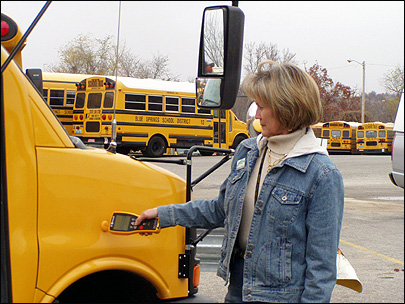Nov 09, 2006A school district in Missouri is revving up an RFID system this week designed to help its transportation department ensure buses transporting more than 10,000 students daily run safely and smoothly.
The Blue Springs School District has installed passive, 125 kHz RFID tags on 147 school buses, equipping drivers and mechanics with handheld RFID interrogators to read those tags. The Electronic Vehicle Inspection Report system (EVIR), from Zonar Systems, went live this week, after several months of installation, testing and training, says Glen McMillian, director of transportation for the school district. The district is also using Zonar Systems' GPS technology on the buses.
Each day, at the beginning of their shifts, drivers inspect their assigned buses to make sure all equipment and mechanics are operating properly. The inspections are part of state- and federally-mandated checks to ensure transportation safety, according to Bill Brinton, Zonar's director of marketing. Until now, the district's drivers performed the inspections manually, filling out forms on clipboards and turning them in at the end of their shifts.
Now, the school district has installed round yellow buttons in various places around the bus. Measuring approximately an inch and a half in diameter, these buttons contain RFID chips. Software running on the handheld interrogators takes a driver through a series of questions about the vehicle’s mechanical systems. At the same time, it directs the driver to visit specific RFID-tagged areas, or zones, on the bus and check certain items, such as the brake lights, rear tires, overhead interior lights and emergency exits. Upon arrival at each tagged zone, the driver waves the handheld near the RFID tag, which time- and date-stamps the answers given to the questions associated with that zone. The driver can enter any concerns directly into the handheld, and even request another bus in the event that the vehicle isn't safe to drive or fails an inspection.
The driver then returns the handheld to a cradle affixed inside the vehicle, which sends the data wirelessly via a cellular network to secure servers at Zonar Systems' Seattle headquarters. If the customer prefers, Brinton says, the data can also be sent via a short-range 900 MHz proprietary network, also developed by Zonar Systems. Blue Springs School District employees can access the Zonar Systems' hosted application using a Web browser to review the inspections and, if necessary, dispatch another bus. Post-trip inspections can also be performed using the system.
According to McMillian, the system results in inspections that are more thorough and accurate because the drivers have to go into each area of the bus that gets checked. The system verifies and electronically stores each inspection and its duration. "It is just a more efficient way to ensure the safety of our bus," he says. "It assures you that the drivers are there, looking at what they should be looking at, on an everyday basis. I'm not saying they ever did this, but [the drivers] could have just sat in the school bus seat and filled out the paperwork, without really performing the inspection."
The system offers other benefits, as well. For one thing, if a bus is pulled out of commission for failing an inspection, it is sent to a shop so mechanics can make repairs. The Blue Springs School District has linked the EVIR system to its maintenance software. As such, once the bus is fixed, the mechanics can perform the same inspections using the handhelds, then update the transportation department's records with the information from that check. "That all validates the bus is ready to go back out on the road," McMillian says.
With all the inspections, safety checks and maintenance information now electronically stored, Blue Springs has far fewer paper records with which to contend. In addition, the district has installed on each bus a GPS module linked to the Zonar EVIR system, allowing it to track where each bus is, when it stops, how long it idles and how fast it travels. All the GPS data can be used with the district's bus-routing software. "Now, if a parent calls to find out if the school bus has already passed a stop, we can provide that information," McMillian says. "This has really turned out to be a great management tool."
The Zonar EVIR system cost the Blue Springs School District about $115,000 to equip all 147 buses and 200 drivers. Still, McMillian says the cost was well worth it, adding, "I think it will more than pay for itself within two to three years."


